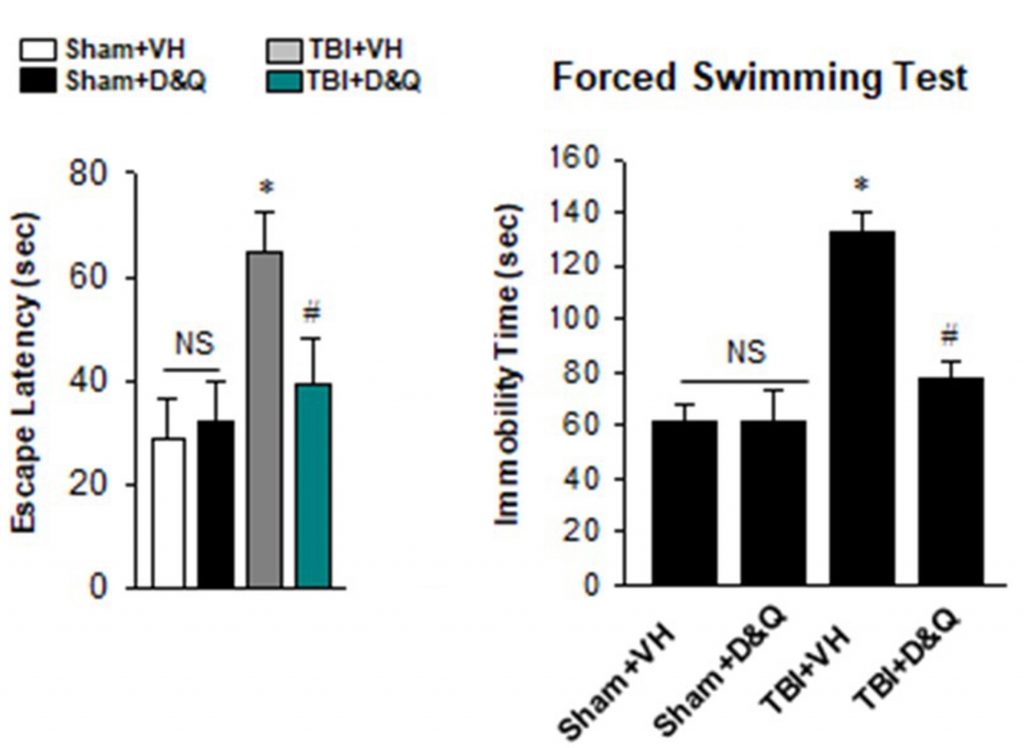Key Points:
- D + Q preserves memory and prevents depression in a mouse model for traumatic brain injury (TBI).
- Inflammation is reduced in the brain of TBI mice following D + Q treatment.
- D + Q treatment mitigates neurodegeneration triggered by TBI.
Chronic brain inflammation is a primary affliction of TBI that scientists surmise inflicts neurodegeneration. Such inflammation may be caused by senescent cells, which contribute to driving the aging process.
Now, researchers from Augusta University in Georgia show that senolytics — compounds that selectively destroy senescent cells — could benefit TBI patients by mitigating neurodegeneration. As reported in Frontiers of Neuroscience, Wang and colleagues show that the senolytic combo D + Q protects the brain from inflammation, neurodegeneration, and memory loss in mice following TBI.
Senolytics Treat Memory Loss, Inflammation, and Neurodegeneration
To model TBI in mice, Wang and colleagues implemented a precision device to directly impact the brain with a well-controlled piston. One month following TBI, D + Q was fed to the mice for 3 consecutive days per week for 13 weeks.
After D + Q treatment, the researchers evaluated the learning and memory of the TBI mice. To do so, they placed the mice into a maze (Barnes maze test) and measured the time it took for them to escape. The results showed that D + Q treatment greatly reduced the escape times, suggesting that senolytic therapy preserves memory even 1-month following TBI.
To test depression-like behavior, the TBI mice were placed into a pool of water. While taken out of the pool before drowning, a lack of swimming implied the mice were unmotivated to save themselves. Since untreated TBI mice swam for about half the time as normal mice, they were considered depressed. However, D +Q-treated TBI mice swam for about the same amount of time as normal mice, suggesting that D + Q prevents depression.

Wang and colleagues next checked if D + Q treatment improved the memory and motivation of TBI mice by reducing brain inflammation. The reasoning behind this is that senescent cells are known to secrete proinflammatory proteins, so removing them should reduce these proinflammatory proteins from the brain.
Indeed, the researchers found that D + Q reduced a major pro-inflammatory protein called IL-6, which was elevated in untreated TBI mice. These findings suggest that D + Q reduces brain inflammation by removing senescent cells and the pro-inflammatory proteins they secrete, allowing for improved memory and motivation in TBI mice.

Chronic inflammation leads to organ degeneration and cell death. In the brain, such tissue degeneration is called neurodegeneration. Because D + Q treatment reduced brain inflammation in the TBI mice, Wang and colleagues also measured neurodegeneration to determine if this too was reduced.
To do so, the Georgia-based scientists used Fluoro-Jade C (FJC), a fluorescent dye that stains degenerating neurons, allowing degeneration to be detected with a specialized microscope. It was found that FJC staining was elevated in several brain regions of the untreated TBI mice. However, in comparison, FJC staining was markedly reduced in TBI mice treated with D + Q. These findings suggest that D + Q mitigates neurodegeneration.

Overall, the findings of Wang and colleagues suggest that D + Q preserves the memory of TBI mice by reducing brain inflammation and mitigating neurodegeneration. Since D + Q was administered 1-month following TBI, D + Q can potentially treat the consequences of TBI long after the occurrence of the initial brain injury.
Traumatic Brain Injury and Accelerated Brain Aging
The latest research points to TBI accelerating brain aging. This is because, like TBI, brain aging encompasses memory loss from brain inflammation and neurodegeneration. Moreover, a recent study showed that TBI patients have “older” brains than normal, as assessed by neurodegeneration levels, which were correlated with poor verbal memory.
Considering the commonalities between TBI and brain aging, it is possible that senolytic therapy, including D + Q, could slow brain aging. While there is a lack of studies testing this concept in humans, the idea is supported by animal studies. For example, the senolytic ABT-737 improves memory and reduces inflammation in a mouse model for Alzheimer’s disease. Furthermore, another senolytic, ABT-263 improves the memory of middle-aged mice.